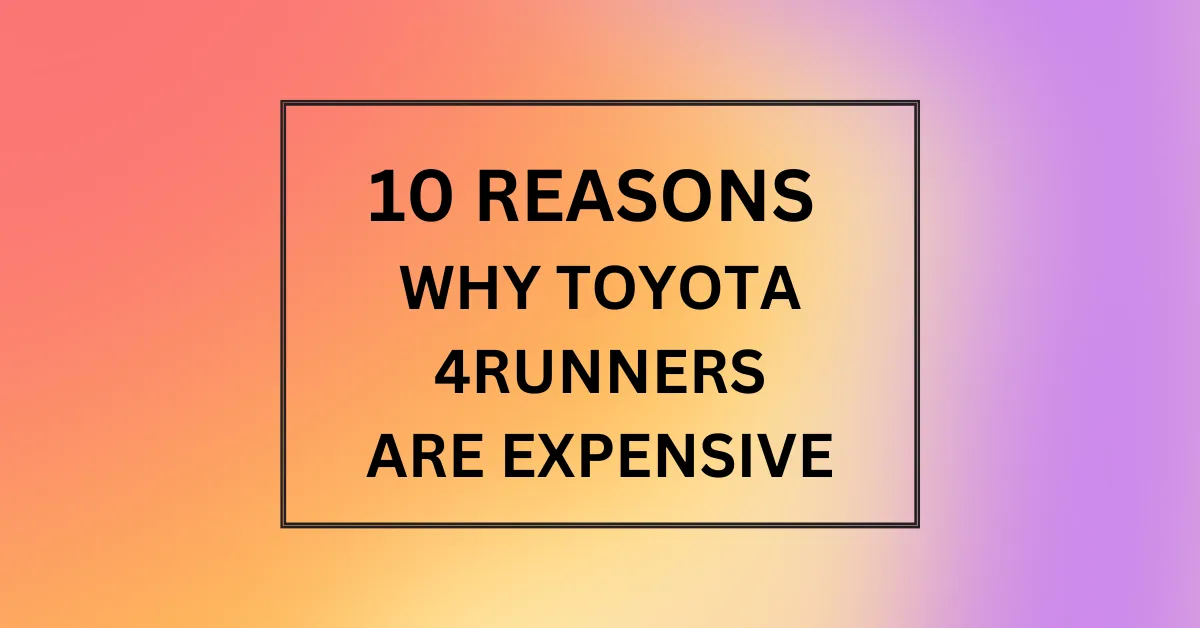Toyota 4Runners are expensive because of their strong brand reputation for off-road capability and reliability which creates high demand, along with body-on-frame construction costs, standard advanced safety tech features, strong resale values, and limited incentives from Toyota allowing them to charge a premium price. Shortages and high inflation also enable Toyota to continue pushing 4Runner pricing higher each model year given constrained supply and rising business costs.
The 4Runner is Toyota’s mid-size SUV, slotting between the smaller RAV4 and larger Highlander. Built on a truck frame, it’s designed for off-road performance with available four-wheel drive across all trims. While more traditional SUVs have transitioned to car-like unibody construction, the 4Runner sticks to its truck roots. This body-on-frame build and off-road tech contribute to its higher cost.
Top 10 Reasons Why Are Toyota 4runners So Expensive
1. Cult Following and Popularity
Toyota knows the 4Runner’s cult following allows them to charge more. The 4Runner continues to grow in popularity year after year among outdoor enthusiasts. With unmatched off-road credibility and Toyota reliability, buyers are willing to pay a premium for the 4Runner’s capabilities.
Toyota is aware of this loyal following and uses it to justify the 4Runner’s higher pricing compared to some other midsize SUVs. Supply and demand allows Toyota to asks top dollar for the venerable 4Runner.
2. Body-on-Frame Construction
Body-on-frame construction costs more but enables off-road readiness. Most modern crossovers and SUVs use cheaper unibody designs to save money. But the 4Runner utilizes an old-school body-on-frame build that better handles off-road abuse.
This truck-style layout offers greater durability but costs more to produce. Unibody vehicles also achieve better fuel economy with lighter weight. But the 4Runner’s buyers prioritize capability over efficiency or value. Its truck foundation necessitates higher manufacturing costs passed onto buyers.
3. Standard Advanced Safety Features
Toyota Safety Sense and other tech features come standard. Today’s buyers expect the latest high-tech safety equipment even on base models. The 2023 Toyota 4Runner comes standard with Toyota Safety Sense P, including pedestrian detection, lane departure warning, automatic high beams, adaptive cruise control, and pre-collision warning.
Higher trims add extras like parking sensors, blind spot monitoring, and rear cross traffic alerts. Loading up on tech like this was once reserved only for luxury vehicles. But now it gets baked into the 4Runner’s sticker price.
4. Competition from Premium SUVs
Stiff competition in the midsize SUV segment values premium interiors. Midsize SUVs competition has grown red hot. Buyers comparing the 4Runner to rivals like the Jeep Grand Cherokee find outdated tech and materials inside. Lacking the plush interiors found elsewhere, Toyota still offers premium pricing.
As competitors up their game on creature comforts and cabin quality, Toyota faces pressure to justify why you should pay more for the 4Runner’s spartan finishes. Affordable versions of luxury SUVs also vie closely with the 4Runner on pricing.
5. Strong Resale Value
Resale value stays insanely high on used 4Runners, propping up new pricing. If you’ve ever checked 4Runner resale values, they seem almost unbelievable. Even fairly old 4Runners with over 100k miles sell for big money because demand outpaces supply.
When vehicles retain this much value in the used market, it directly allows automakers to maintain higher new vehicle pricing. Because buyers know they’ll recoup more resale value down the road, Toyota can bake this benefit into current transaction prices.
6. Limited Incentives/Discounts
Discounts and incentives are less common on the attention-grabbing 4Runner. Some vehicles rely heavily on rebates, cut-rate financing, and other incentives to attract buyers. But the beloved 4Runner flies off dealer lots at full price without much need for incentives.
When supply is constrained and buyers line up on waiting lists, automakers have little motivation to offer discounts. With brand cachet and RAV4-rivaling sales figures, Toyota discounts 4Runners far less than most other models. Less promotions means more profit and latitude on pricing.
7. Reputation and Brand Cachet
Strong brand reputation allows Toyota to leverage the iconic 4Runner nameplate. Over nearly 40 years, the 4Runner has earned immense brand equity as one of the most respected, longest-running SUV nameplates. Buyers connect with its heritage emphasizing reliability, durability, and off-road mastery.
The 4Runner enjoys major cred within overlanding circles and outdoor adventure types. Toyota banks on this revered reputation that makes the 4Runner a lifestyle vehicle beyond just transportation. Loyal enthusiasts are more willing to pay extra for such an admired icon.
8. Shrinking Compact Truck Platform
Compact truck frames underlying the 4Runner grows increasingly rare. As body-on-frame SUVs fade away, one supporting factor remains the shared truck architecture enabling 4Runner’s construction. By basing the 4Runner on existing truck components, Toyota contains costs better than engineering a unique frame.
But compact truck platforms like the 4Runner’s have become an endangered species as automakers nix small pickups. With fewer donors to share development expenses, the 4Runner’s niche frame grows more expensive to sustain. And those costs inevitably push transaction pricing upward.
9. Ongoing Supply Shortages
Ongoing shortages hamper production and constrain 4Runner supplies. Like all automakers, Toyota continues battling pandemic-related shortages of components and supplies. Computer chip and other upstream parts delays make it tough to ramp up 4Runner production.
Constrained manufacturing capacity keeps supplies tight amid soaring customer demand. This combination of stretched supply chains and through-the-roof demand hands over pricing power to Toyota and dealers. Less discounting also results from shortages making these trucks hard to come by.
10. High Inflation
Soaring inflation works against keeping 4Runner pricing stable. Surging inflation represents a final nail in the pricing coffin for capability-focused rigs like the 4Runner. Rising manufacturing, shipping, raw materials, and operating costs cut into automaker profit margins.
In response, brands pass escalating expenses onto consumers through Vehicle Sticker Price (MSRP) increases. On top of steep demand and short supply, fast-rising costs provide cover for Toyota to level up new 4Runner pricing year over year.
Is Toyota 4Runners a good brand?
With 40 years of history emphasizing reliability, durability, and off-road mastery, Toyota 4Runners represent one of the most highly respected SUV nameplates available.
Are Toyota 4Runners good?
Yes, Toyota 4Runners are regarded as excellent off-road capable vehicles, praised for their robust truck-based construction, comfortable ride, and Standard safety tech unavailable on some rivals.
Are Toyota 4Runners worth the price?
Given their unmatched resale values, generous standard equipment levels, and enduring off-road credibility, Toyota 4Runners justify premium pricing for buyers prioritizing capability and long-term value.
Where to buy Toyota 4Runners?
With constrained supply and huge demand, finding Toyota 4Runners in stock can prove challenging, but checking dealer listings regularly and expanded search radiuses can help buyers locate available trucks.

